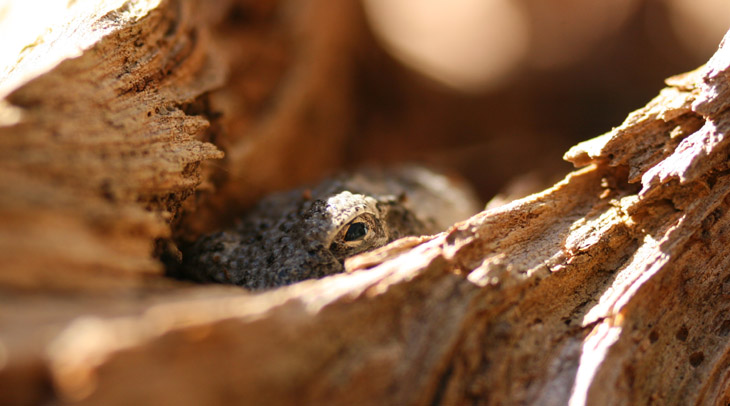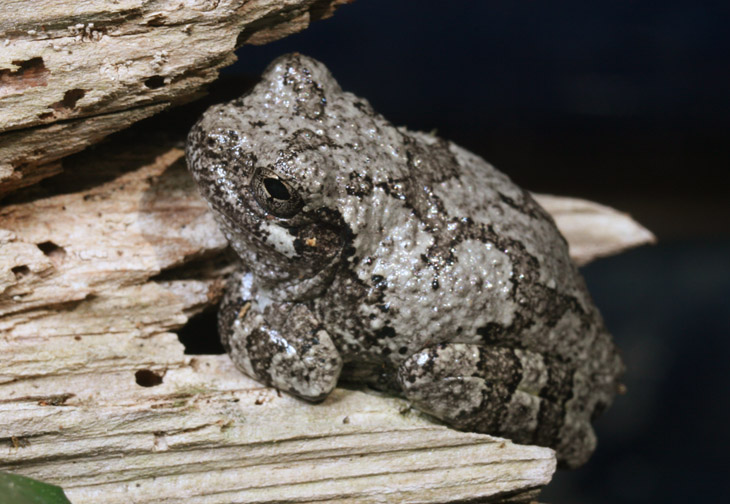This episode of ‘But how?’ is going to deal more with observations than answering any specific questions through a secular outlook; as such, the title question itself doesn’t really fit, but there still may be a lot of things that become clearer nonetheless. So let’s take a look at consistency in regards to religion.
From time to time, I hear the argument that ‘science’ changes all the time, but religion (or whatever the speaker’s personal definition of it, anyway) remains the same, as it always has. There are two immediate observations that demand attention right off the bat. The first is, ‘science’ used in this manner is the body of knowledge gained through scientific means (rather than the process itself) – the facts, not the practice. But since science is a methodical process of learning, reflecting mankind’s horrific lack of omniscience, of course it changes, just like every human being changes every minute of their lives as new experience adds to their store of knowledge. Having it any other way would be remarkably dull and pointless.
But even to think that science (or our body of knowledge) ‘changes’ significantly is warping reality to leverage a particular viewpoint. Our knowledge expands constantly, but not very much of that consists of changing what we once believed into something else. It’s not hard to find changes in dietary recommendations, for instance – even though a lot of these are corrections to radical misinterpretations of scientific studies by popular media and agenda-driven sources – but this is a tiny aspect of scientific endeavor. Physical laws, engineering formulas, the functions of cells, the nature and behavior of electromagnetic radiation, the atomic table, and so on and so on… all hashed out long ago, few of them even being refined, much less changed. We knew, to a large extent, what DNA did before we even knew what it was. In fact, a large portion of scientific findings right now consists of confirming theories and suspicions, such as gravitational waves, the Higgs boson, and even relativistic time dilation. To say that science constantly changes broadly implies that someone who got their PhD fifty years ago would find it to be worthless now, which of course is far from the case.
The second point that must be highlighted with such an attitude is, to think that religion – any religion, or even any aspect thereof – remains the same only demonstrates a stunning ignorance of religious history. Religion doesn’t quite change as much as, say, fashion, but it’s a lot closer to that than to any charitable or even magnanimous definition of “unchanging.”
Even on very small scales, there is little consistency to be found. In a previous post I expressed significant doubt that any two religious people could agree on a majority of ‘facts’ about their religion, which is especially amusing since the structure of so many faiths is to follow the pronouncements of their religious leaders, regardless of how little sense they might make or any ability whatsoever to support such pronouncements with evidence; “faith” is itself a structure of unquestioning acceptance. Most religions are built on authority, and as we are told, there is only one authority to be found… well, okay, not to be found in any way, but there nonetheless. We know this because we have it on good authority – just, not the authority which is the only authority that counts; mouthpieces are enlisted instead, spokespeople for an omnipotent being, because. Seriously, we never get any better explanation than, “because.” This state of affairs results in more schisms, sects, and splinters than any other topic you can name; put this down to hyperbole if you like, but if you do find a topic that is more fractured and scattered than religion, the comparison still won’t be complimentary. Any devotee will be happy to tell you how correct their own version is without cognizance of the bare facts that a) their version is not followed by many people, and b) it did not exist a hundred years ago. That sounds enormously contentious, and anyone is welcome to dispute it; show me how the attitudes, proscriptions, practices, and rituals are exactly the same as they had been – I wish you the best of luck. In the meantime, we are expected to believe that billions of people over the history of mankind got it all wrong until right here and now, when this handful finally got it right. Even if there were some way to establish this ludicrous proposal as absolutely true, it’s rather damning of religion itself being able to fulfill the one function that it has.
More entertaining are the inconsistencies found within any given faction. We are often assured that scripture (any scripture you care to name) is god’s word and therefore irrefutable fact, but we somehow cannot find anyone that doesn’t willfully ignore those sections that they find inconvenient. At best, we get to hear that said sections are intended only metaphorically, but how this is determined is never fully explained – it’s certainly not a consistent set of rules or indicators that are followed throughout, applicable without fail to all aspects of scripture. Moreover, there is no agreement over which sections are metaphorical and which are literal Truth™, but there is a certain ironic trait to be noted: some of the sections largely considered metaphorical gained this current status because science demonstrated that they could in no way be literal.
[It occurs to me that a large number of religious folk may be entirely unfamiliar with this, since their perspective comes solely from their personal involvement in their church or temple or whatever, which not only fosters at least some consistency, but rarely involves any questioning at all. Yet as an outspoken atheist that’s quite active online, the huge variety of beliefs and practices is apparent. While I’m more than happy to consider any given viewpoint as a personal perspective, those presenting such perspectives never have the attitude that these are individual views, but rather representative of The One True Way – often enough with commensurate condescension over anyone who fails to recognize this. I shouldn’t need to remind anyone how frequently such attitudes result in bloodshed, either.]
The various schisms shouldn’t be surprising, however, when we recognize that few, if any, collections of scripture maintain any consistency within – not in message, not in tone, not in guidance and ideals for humankind, not in portrayal of events nor their connection to other historical records, and most especially not in concordance with demonstrable physical properties. One would think that Truth™ would be easily demonstrable, certainly not in disagreement with the world around us – and yet, these disagreements, such as promises of otherworldly realms and the assurance that miracles do indeed take place, are almost what defines religion. While physical traits and laws are dependable, repeatable, and predictable, concepts such as ‘supernatural’ and ‘metaphysical’ exist as departures from this consistency, unable to be demonstrated or even defined firmly; as such, anyone can use them virtually at will. The vague nature of these terms means that they can only serve the purpose of self-confirmation, since there are no standards to be met and thus no way to actually rule them out.
As a small aside, note how often the people who find ‘supernatural’ influence in everything from being uninjured in a car accident to finding their lost sweater somehow manage to show how their god is caring. When the bad things happen, these are never ‘miracles’ – a curious set of evidential standards. On those rare occasions when death comes to someone they know, there is often no hesitation in claiming this is still part of a plan, with the assumption that this is a beneficial plan, though how this could possibly be determined remains unknown. Faced, however, with the overwhelming evidence that things on this planet can in no way be considered universally good, a lot of religious folk quickly point the finger at people being flawed – despite their assertions that we were all made by a perfect being. If this is all part of a plan, doesn’t this mean that it makes no difference what we do or how we behave?
Even ignoring those overriding issues, there is the simpler one that most scripture cannot even agree with itself, featuring countless contradictions within. Coupled with imprecise passages wide open for interpretation, as well as the tendency among to faithful to choose only those passages that fit a specific purpose, we find that scripture can be used as justification for just about any behavior imaginable, bringing us back once again to how often the practices of any given religion have changed over time. Take a quick look at the hotbutton issues of any religious group, and compare them to what was considered important just three decades ago, much less one hundred, two hundred, or five hundred years ago. It is especially amusing to see how many women are openly religious, given the fact that all of the abrahamic scriptures dictate how little influence females are permitted to have. Those sections aren’t actually part of the plan, I’m guessing.
As you might imagine from the other subject matter on this blog, I have a lot of exposure to those that try to argue against evolution, and the inconsistencies in these discussions are vast. They range from the simpler, “evolution takes place, but it was all started by god long ago,” to the fundamental creationist standpoint that the Earth is only 6,000 years old and every other interpretation is fostered by satan – good thing the religious have it all spelled out for them and can agree on this issue. Even intelligent design, a concept claimed to be scientific in nature that nevertheless shows how god must exist, has two interchangeable definitions of ‘irreducible complexity’ that don’t logically intersect. And yet there is a notable consistency among many religious debaters – not perfect, mind you, but transcending most demarcations among the religious that anyone cares to make – and that is the standards of evidence and proof. Evolution, naturally, is proven completely false by any inconsistency found therein, any lack of direct evidence, any two factors which do not seem to agree, and this is regardless of how little the religious debater actually understands about evolution (which is most often very little indeed, despite how simple it really is.) Holding any religion at all up to the same standards would trash it instantaneously, which is naturally why it is never done. This appears very distinctly in many arguments, often revolving around those people who blindly follow the pronouncements of scientists or the dogma of science itself, despite the fact that religion is built upon these two concepts and could not exist without them – faith is good when the religious do it, but not when it’s perceived to be done by anyone else. That science is, by nature and practice, diametrically opposed to the concept of faith is simply never grasped in such conversations.
More amusing is how science is actually used in the same discussions, far too often. An oft-repeated canard is that the second law of thermodynamics disproves evolution, demonstrating how little the person using it actually understands about physics, but much worse, the first law of thermodynamics trashes gods in every named form. This selectivity in finding science useful or delusional occurs quite often (and not just among the religious, it should be said.) In discussions on the studies that found portions of existing DNA in dinosaur bones, the religious arguments often revolved around a) it being impossible for DNA to exist that long, and b) that testing would show that the bones weren’t really that old. Both of these, naturally, are scientific processes, ones that weren’t ignored during the original studies, but apparently one can pick and choose the science that they find dependable (I think it revolves around how conveniently it supports a pre-existing view.) Don’t get me wrong: scientific findings do indeed clash, and can be used to prove previous studies wrong – it happens quite frequently. But such changes in scientific knowledge take place with careful demonstrations, rather than the typical religious argument that if we evolved from monkeys we shouldn’t still have monkeys. I’ve said it before, but there’s something precious about the faithful soul that thinks their cute little canard somehow would never have occurred to the thousands of scientists who have been working with the same concepts for decades.
I’ve also remarked before about the hypocritical double-standard of personal choice and ultimate authority, shown far too often by religious folk. When confronted with much of the same stuff above, or the combined nonsense and pointlessness of most of their scripture, the defense is that religion is a personal choice, and even a right that they possess (it’s not – it just cannot really be denied, like whether or not one likes vanilla ice cream.) Personal choices, however, are never used to influence legislature, to dictate how children should be raised, or even to slaughter infidels. Personal choices do not extend beyond one’s own brain; anything else obviously isn’t ‘personal.’ And if we are recommending (or forcing) any course of action for anyone else, we should be able to rationally support such with the overriding beneficial aspects, rather than some childish appeal to writings several thousand years old that do not even present the planet in the correct shape. But note, too, that the argument of religion as a personal choice vanishes as soon as the individual leaves the arena of debate, and becomes Truth™ everywhere thereafter.
There are more amusing bits. I can’t tell you how often I’ve heard variations of the argument that there are too many religious people in the world, so they can’t all be wrong. Aside from the simple response of, “why can’t they?”, there is the curious double-standards of category that arise every time this argument appears; all of a sudden, every religion can be joined together in harmony – the Native American who believes in a trickster god somehow supports the concept of karmic rebirth, it would seem. The argument also somehow skips over the bare fact of how many people the world over believe in all of the scientific findings we’ve made over the centuries, like the age and origin of the earth and how long life took to develop. It also ignores the plain, simple fact that it doesn’t really matter what anyone believes, since opinion does not establish reality; what kind of results can be produced? We’re still waiting for that, from any religion…
Also, curiously, a lot of religious folk seem to somehow believe that everyone who promotes the concept of, you know, physical laws and life as happenstance is forwarding an agenda, yet their church, which wouldn’t even exist without both a faithful flock and a shitload of donations, is only interested in promoting Truth™. And let’s not forget the argument that atheists and their ilk never tackle sophisticated theology, despite the fact that 99.9997% of religious folk have absolutely no knowledge of such themselves and never produce it when making their own stand. Add in how atheists never pick on the reactive and bloodthirsty religions, but only the peaceful and non-reactive ones like those that the arguer belongs to – despite professing that there is only One True Religion.
[Another aside: in the aforementioned case, islam is usually the ‘reactive’ religion in mind, demonstrating how few people understand that islamic terrorism is a tiny, radical subset of a larger faith that is no more violent than christianity – all of them have their extremists. And while extremism can have many root causes, the concepts of ultimate authority and deity-approved actions certainly aren’t detrimental, are they? Nor are they specific to any religion, imagine that.]
I could go on, but I suspect the overall claim of consistency is effectively trashed. There is a more interesting concept that can be found within, however, and that’s how often the rules and standards and practices exist only as far as they support the religious standpoint. If one already has a preferred answer and selects only the stuff that supports it, then a case can be made for anything at all. A consistent set of practices and standards, however, especially ones that predict results, are the only things that will tell us when we’re on the right track – anything else is self-indulgence.
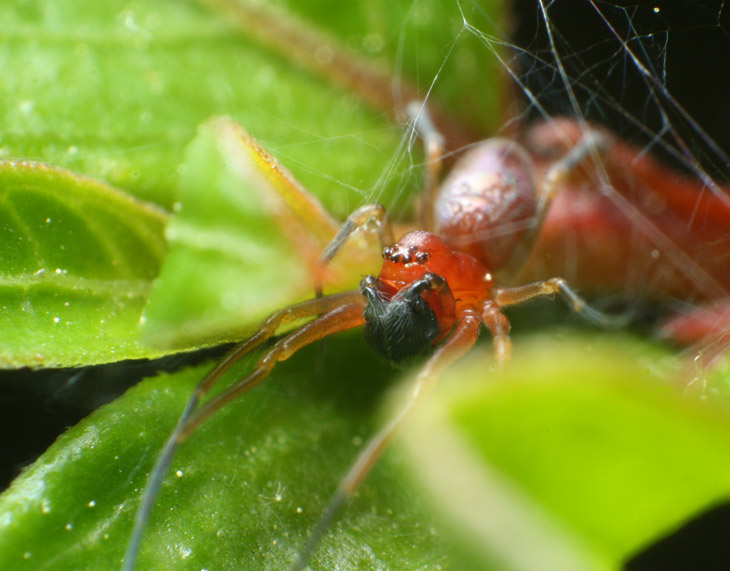
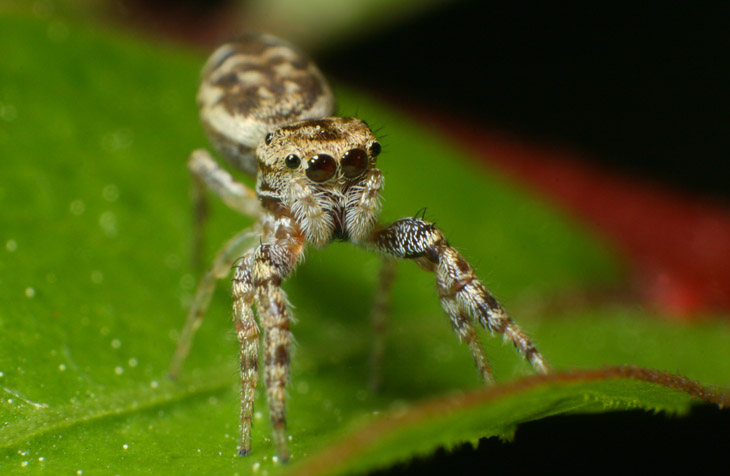
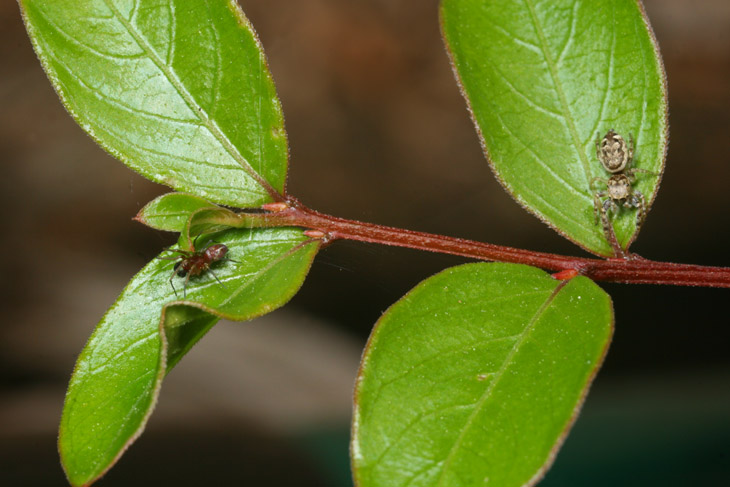
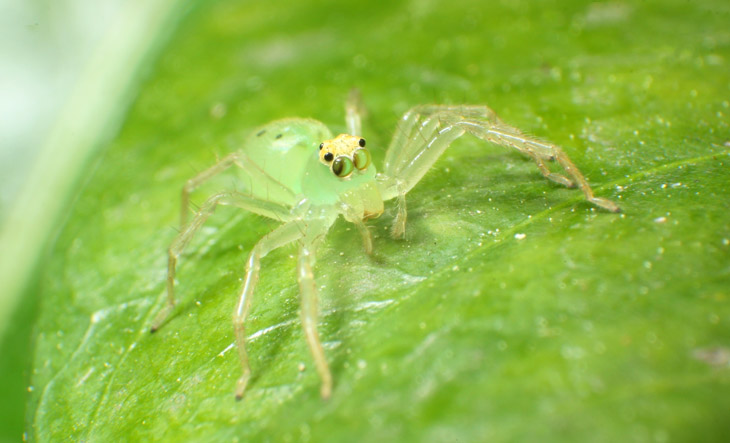
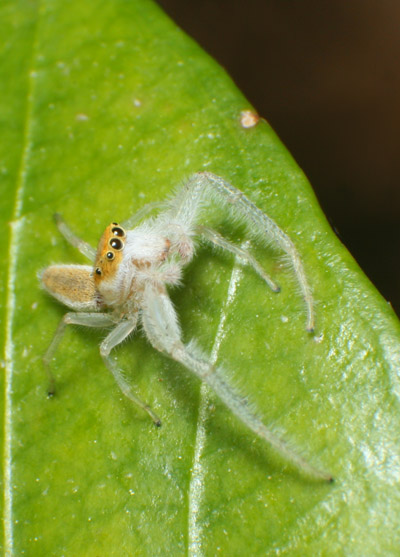 Another denizen very close by was a jumping spider fairly common around here, though BugGuide.net lists their range only as ‘Florida.’ This is a Hentzia mitrata, no apparent common name, so we will call them peachfuzz for obvious reasons. This one came very close to a magnolia green, but went past and tried to take shelter from my presence against a stem, before gaining the topmost leaf and viewing me alertly. Some jumpers are fearless, some are shy, and these seem to split the difference; after its attempts to disguise itself against the stem failed to work, it sat in plain view and intently watched me and the camera, in this image probably viewing the softbox reflector hanging out over the lens. More images of the same species from last year, including a fartistic one, can be found here.
Another denizen very close by was a jumping spider fairly common around here, though BugGuide.net lists their range only as ‘Florida.’ This is a Hentzia mitrata, no apparent common name, so we will call them peachfuzz for obvious reasons. This one came very close to a magnolia green, but went past and tried to take shelter from my presence against a stem, before gaining the topmost leaf and viewing me alertly. Some jumpers are fearless, some are shy, and these seem to split the difference; after its attempts to disguise itself against the stem failed to work, it sat in plain view and intently watched me and the camera, in this image probably viewing the softbox reflector hanging out over the lens. More images of the same species from last year, including a fartistic one, can be found here.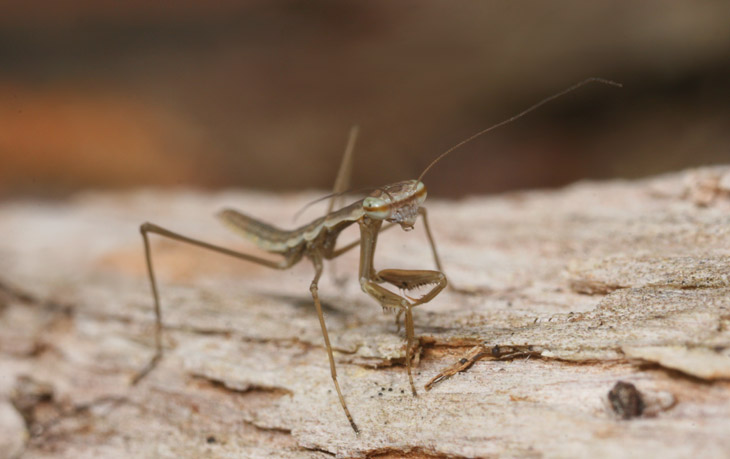
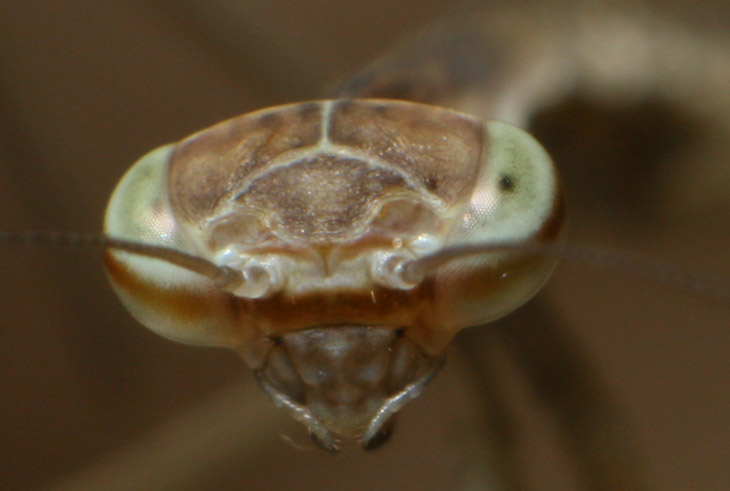





















































 It’s safe to say that this blog is wordy, which is one of the more significant ways that it distances itself from social media; the quick memes and the sound bites are not really at home here. And this is largely because they’re far too simple to be of any use. Take this image here, lifted from
It’s safe to say that this blog is wordy, which is one of the more significant ways that it distances itself from social media; the quick memes and the sound bites are not really at home here. And this is largely because they’re far too simple to be of any use. Take this image here, lifted from  I have an idea: let’s all pretend that we are not getting unseasonably cold weather after the spring rebirth has begun, and that the temperatures are remaining exactly where they should be. In fact, let’s insist on it, in ALL CAPS if need be – it seems to work for religious folk…
I have an idea: let’s all pretend that we are not getting unseasonably cold weather after the spring rebirth has begun, and that the temperatures are remaining exactly where they should be. In fact, let’s insist on it, in ALL CAPS if need be – it seems to work for religious folk…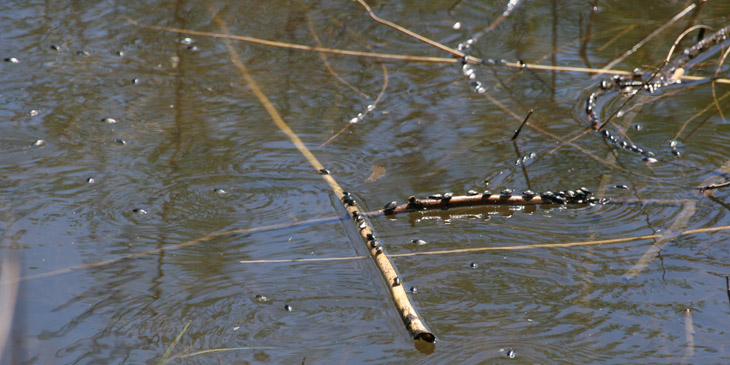
 That was about it for Jordan Lake, at least the area that I checked out, save for a lot of wisteria that was still hanging on. Wisteria tends to peak and disappear quickly, and most of what I saw was just passing optimum appearance, starting to wilt and turn brownish in places, but it was still better than my immediate area where all such blooms have already disappeared. So for this shot, we return to the Botanical Garden and take another upward view, this time a white rose against a brilliantly deep blue sky. I did a couple of compositions, both with and without the cloud, but selected this one because the cloud seems to complement the blossom well. I tend to shoot different perspectives and approaches for many of my subjects, not just satisfying myself but also maintaining stock for potential clients who might have different tastes than I do. In the interests of space I usually only feature the one I like the best on the blog, but it’s rare that I only have one version of any given photo.
That was about it for Jordan Lake, at least the area that I checked out, save for a lot of wisteria that was still hanging on. Wisteria tends to peak and disappear quickly, and most of what I saw was just passing optimum appearance, starting to wilt and turn brownish in places, but it was still better than my immediate area where all such blooms have already disappeared. So for this shot, we return to the Botanical Garden and take another upward view, this time a white rose against a brilliantly deep blue sky. I did a couple of compositions, both with and without the cloud, but selected this one because the cloud seems to complement the blossom well. I tend to shoot different perspectives and approaches for many of my subjects, not just satisfying myself but also maintaining stock for potential clients who might have different tastes than I do. In the interests of space I usually only feature the one I like the best on the blog, but it’s rare that I only have one version of any given photo. 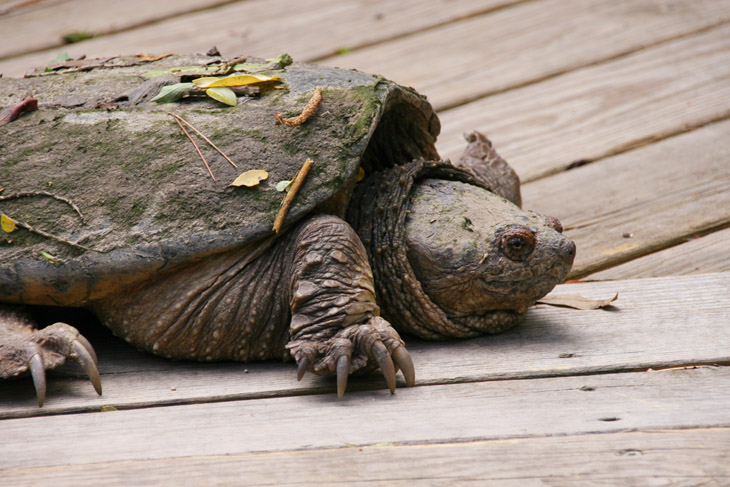
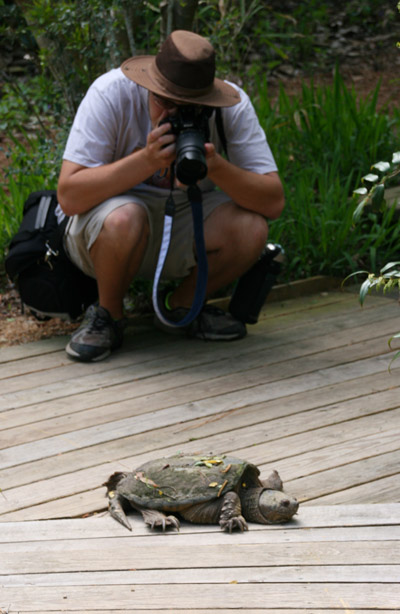 Certainly a carefree and chipper-looking species, isn’t it? You can almost picture it rolling onto its back and playing with a ball of yarn. The mud and algae on the carapace is typical of the species and its habits, only adding to the perky effect of its scaly skin and enormous claws – I think our concepts of how dinosaurs appeared have a lot to do with snapping turtles, since we have no fossil evidence of what dinosaur skin was actually like. Consider, too, how we can see images of Galápagos tortoises and find them mellow, perhaps even kindly in a geriatric way, while we cast a critical eye at snappers like this and only consider them irascible and bellicose, despite having virtually the same behavior.
Certainly a carefree and chipper-looking species, isn’t it? You can almost picture it rolling onto its back and playing with a ball of yarn. The mud and algae on the carapace is typical of the species and its habits, only adding to the perky effect of its scaly skin and enormous claws – I think our concepts of how dinosaurs appeared have a lot to do with snapping turtles, since we have no fossil evidence of what dinosaur skin was actually like. Consider, too, how we can see images of Galápagos tortoises and find them mellow, perhaps even kindly in a geriatric way, while we cast a critical eye at snappers like this and only consider them irascible and bellicose, despite having virtually the same behavior.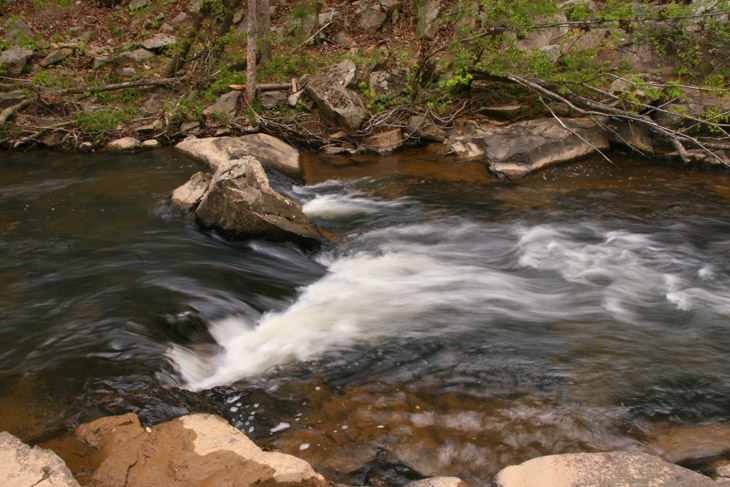
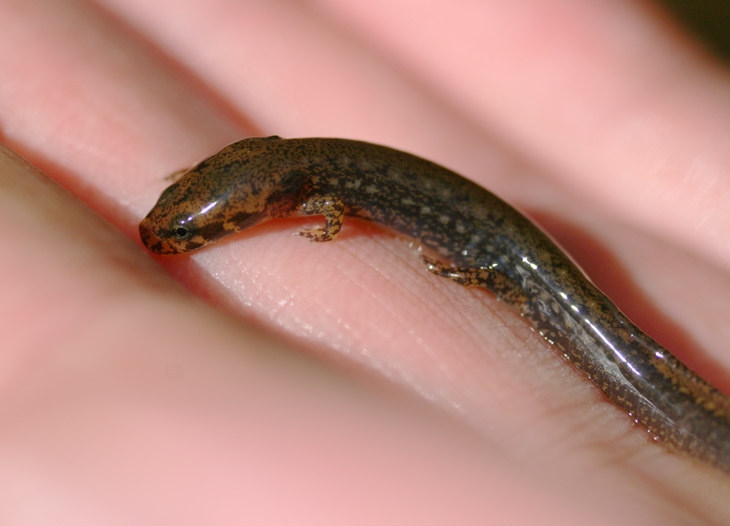
 Immediately before we had to wrap it up for the session, we finally found one of the subjects we’d come down to see, a northern water snake (Nerodia sipedon.) They can often be observed right near the concrete apron where the gravel access road crosses the river – the jumble of rocks and frequent jams of dead trees brought by the currents make an ideal habitat, good hiding places while convenient to the water. This one had found a nice spot, fully exposed to the warming sunlight while sheltered from both the wind and casual observation. I actually compared the markings on this one against the
Immediately before we had to wrap it up for the session, we finally found one of the subjects we’d come down to see, a northern water snake (Nerodia sipedon.) They can often be observed right near the concrete apron where the gravel access road crosses the river – the jumble of rocks and frequent jams of dead trees brought by the currents make an ideal habitat, good hiding places while convenient to the water. This one had found a nice spot, fully exposed to the warming sunlight while sheltered from both the wind and casual observation. I actually compared the markings on this one against the 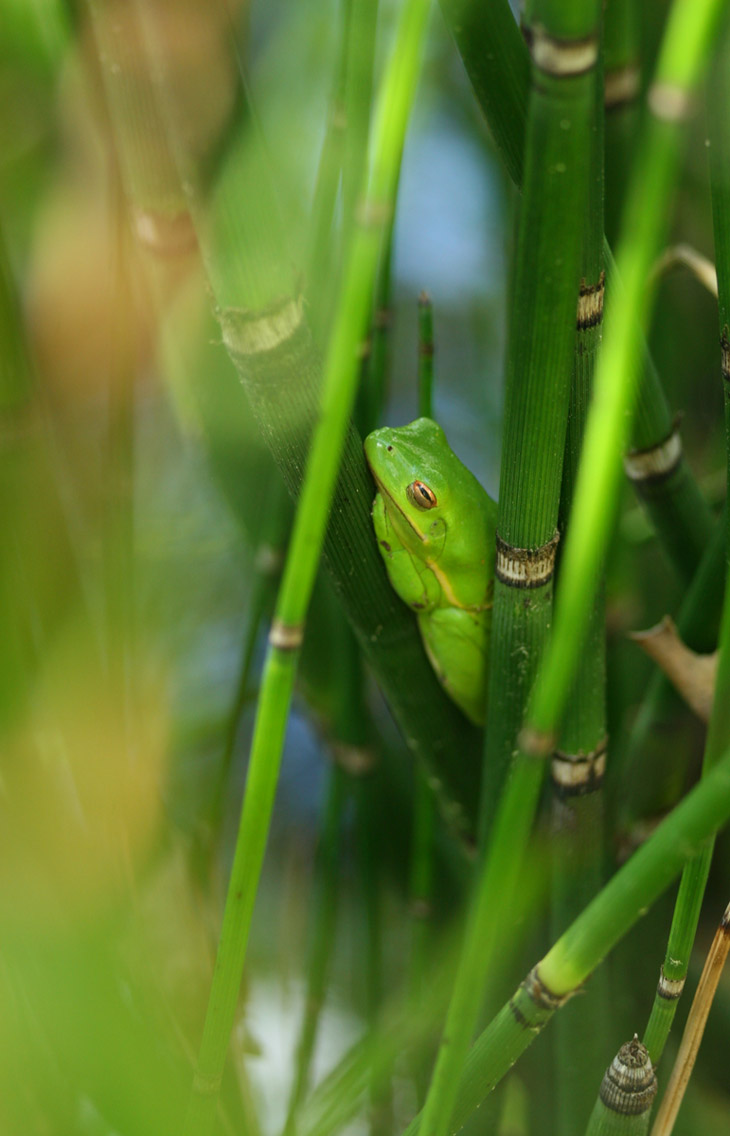
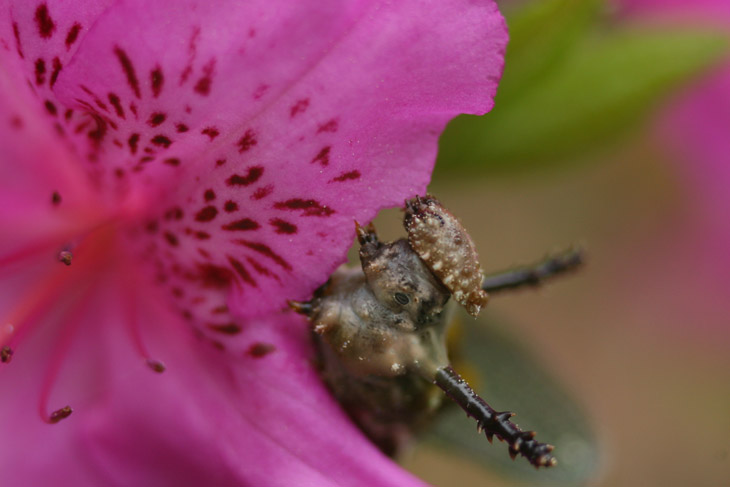
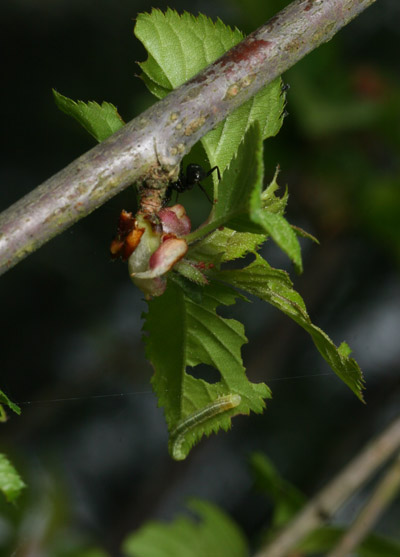 The larva above, one of two such that I found, was assisting the numerous inchworms in raiding the weeping cherry tree, another ornamental that we didn’t want savaged. In that case, however, the ants were helping out an awful lot. The cherry tree came into blossom only a couple of weeks ago, and is now leafing out as well as starting to produce cherries, while the inchworms are partaking of the new leaves. Some of the leaf damage can be seen here alongside the culprit, at center near the bottom of the frame. Directly above it sits a black ant, and the two species demonstrated a paired behavior enough times to know it wasn’t a fluke. As soon as an ant would draw near, before visual contact appeared possible, the caterpillar would bail the leaf to hang beneath on a thin web strand, unable to be captured by the ant. Eventually, once the ant had moved on, the inchworm would draw itself back up to the leaf to resume eating. I never did see an ant actually capture an inchworm, and I’m not even sure that was their main goal, so you might think they were doing little to protect the tree. However, there were a lot of ants, and the ability of the inchworms to eat uninterrupted was seriously hampered by this. While dangling, of course, the inchworms remain vulnerable to any passing bird, or even being carried away by a stiff breeze. They also remain vulnerable to humans with pans of soapy water, which is how a lot of them met their demise.
The larva above, one of two such that I found, was assisting the numerous inchworms in raiding the weeping cherry tree, another ornamental that we didn’t want savaged. In that case, however, the ants were helping out an awful lot. The cherry tree came into blossom only a couple of weeks ago, and is now leafing out as well as starting to produce cherries, while the inchworms are partaking of the new leaves. Some of the leaf damage can be seen here alongside the culprit, at center near the bottom of the frame. Directly above it sits a black ant, and the two species demonstrated a paired behavior enough times to know it wasn’t a fluke. As soon as an ant would draw near, before visual contact appeared possible, the caterpillar would bail the leaf to hang beneath on a thin web strand, unable to be captured by the ant. Eventually, once the ant had moved on, the inchworm would draw itself back up to the leaf to resume eating. I never did see an ant actually capture an inchworm, and I’m not even sure that was their main goal, so you might think they were doing little to protect the tree. However, there were a lot of ants, and the ability of the inchworms to eat uninterrupted was seriously hampered by this. While dangling, of course, the inchworms remain vulnerable to any passing bird, or even being carried away by a stiff breeze. They also remain vulnerable to humans with pans of soapy water, which is how a lot of them met their demise. The ant hadn’t even drawn close, but apparently set up some telltale vibrations along the leaf; the ant has moved out of view behind the leaves here. I’ve found that shaking the branches is often enough to trigger the defensive drop, which makes it a lot easier to find and remove the inchworms.
The ant hadn’t even drawn close, but apparently set up some telltale vibrations along the leaf; the ant has moved out of view behind the leaves here. I’ve found that shaking the branches is often enough to trigger the defensive drop, which makes it a lot easier to find and remove the inchworms.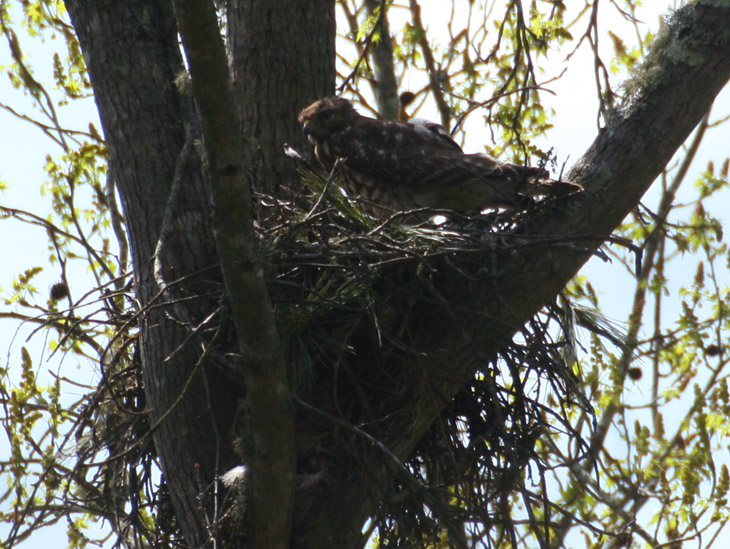 I mentioned earlier about watching a red-shouldered hawk (Buteo lineatus) trying to interest a female in his newly-constructed nest, and he was successful; she is now occupying the nest regularly, and I suspect eggs are soon to arrive if they haven’t already. The distance is a little extreme – this is a tight crop from a frame shot at 500mm – and the light angle is terrible, since my view is due south, so it’s hard to say how much I’ll capture, but I’ll keep watching. You know I’ll keep you updated with any decent pics, and perhaps even some indecent ones.
I mentioned earlier about watching a red-shouldered hawk (Buteo lineatus) trying to interest a female in his newly-constructed nest, and he was successful; she is now occupying the nest regularly, and I suspect eggs are soon to arrive if they haven’t already. The distance is a little extreme – this is a tight crop from a frame shot at 500mm – and the light angle is terrible, since my view is due south, so it’s hard to say how much I’ll capture, but I’ll keep watching. You know I’ll keep you updated with any decent pics, and perhaps even some indecent ones.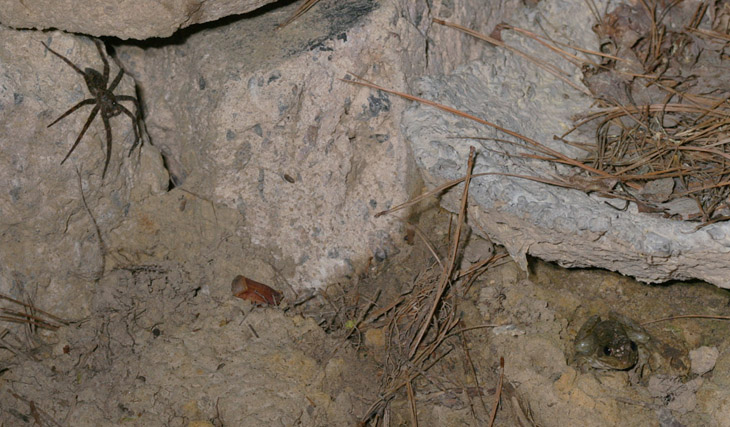
 A pair of green frogs (Lithobates clamitans) wintered over in the bottom of the ornamental pond in the back yard and now make nightly appearances, but what startled me was the fishing spider, which joined them a few nights ago. I could tell you that the frog, at lower right in the image above, is 5cm long and the spider is 2.5cm long in body length (so much more in leg spread,) but it’s more illustrative to show scale. No nature photographers were harmed in the making of this image.
A pair of green frogs (Lithobates clamitans) wintered over in the bottom of the ornamental pond in the back yard and now make nightly appearances, but what startled me was the fishing spider, which joined them a few nights ago. I could tell you that the frog, at lower right in the image above, is 5cm long and the spider is 2.5cm long in body length (so much more in leg spread,) but it’s more illustrative to show scale. No nature photographers were harmed in the making of this image.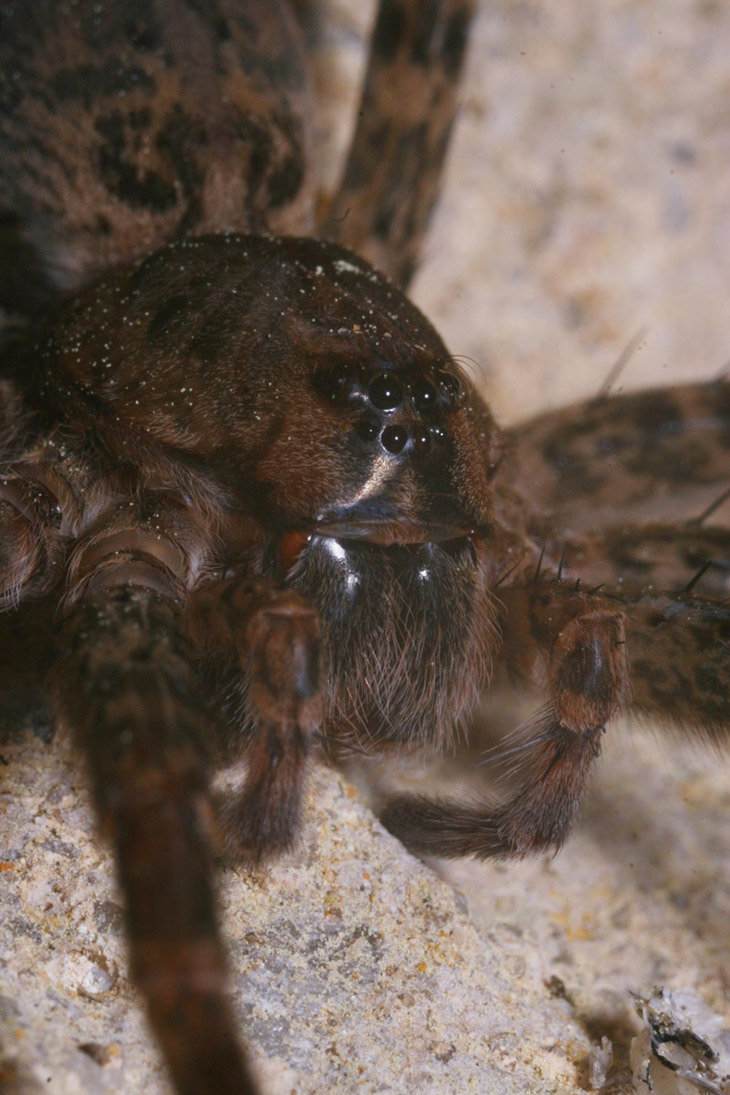
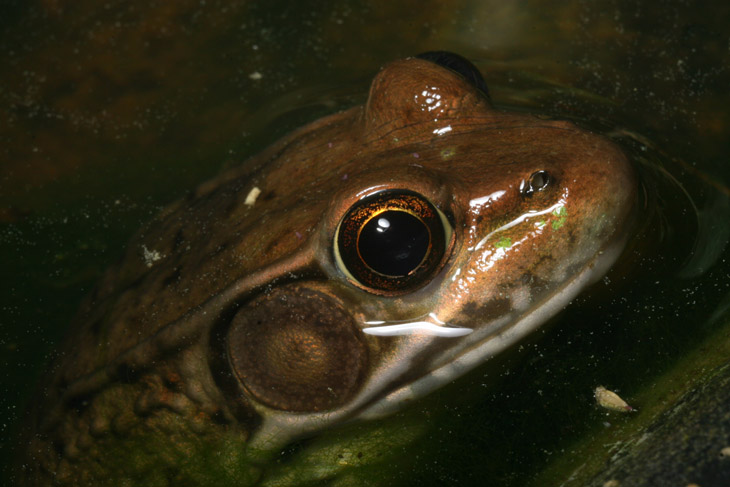


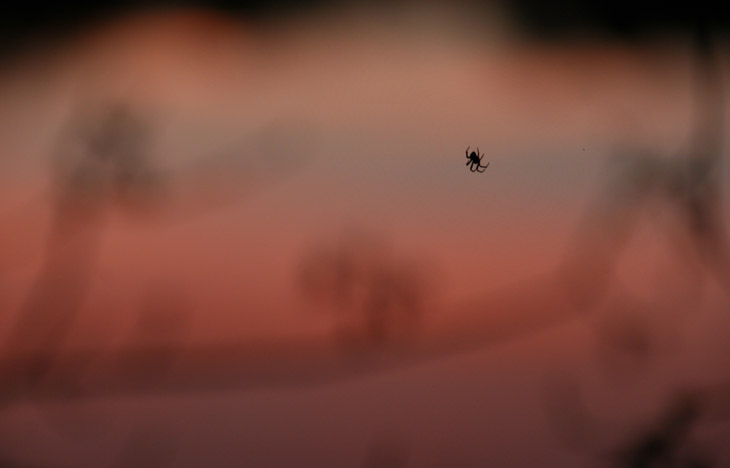
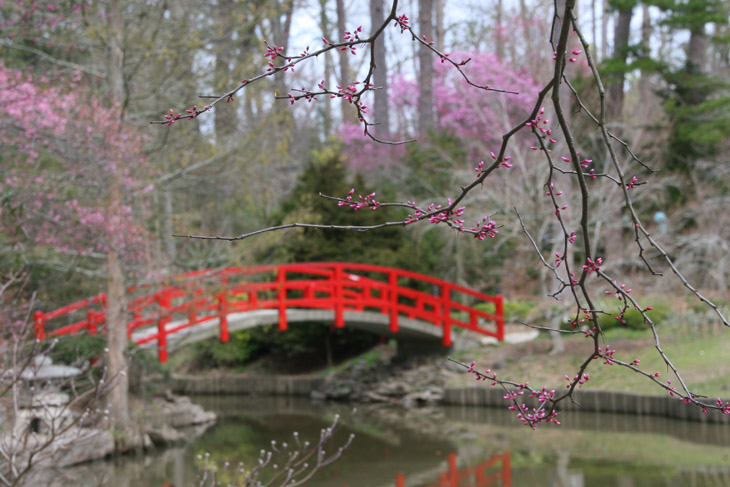
 Does this count? I have to admit I’m not sure, since they were growing in a patch of lawn in the same garden, and I can’t vouch for whether they simply appeared there on their own or were planted – I’m leaning towards “natural,” for whatever definition of that vague term you like. I have not identified these yet; you know, most of our more specific names for colors actually come from flowers, so trying to narrow the search choices down from “blue” or “purple” is hard to do without skewing the results towards something that you know isn’t right.
Does this count? I have to admit I’m not sure, since they were growing in a patch of lawn in the same garden, and I can’t vouch for whether they simply appeared there on their own or were planted – I’m leaning towards “natural,” for whatever definition of that vague term you like. I have not identified these yet; you know, most of our more specific names for colors actually come from flowers, so trying to narrow the search choices down from “blue” or “purple” is hard to do without skewing the results towards something that you know isn’t right.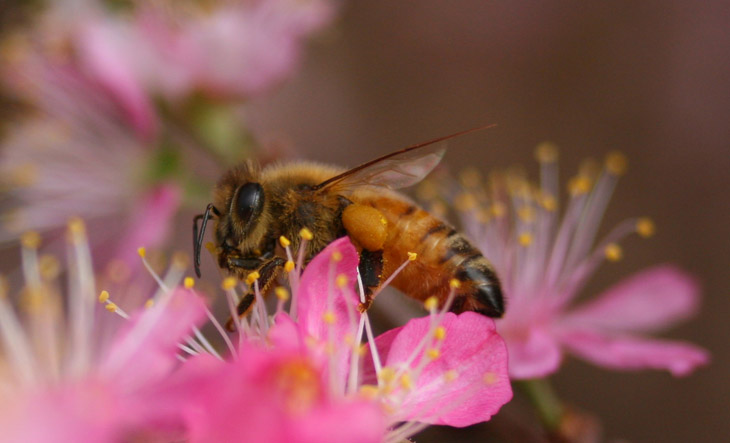 During the same trip, the pollinators were still pretty scarce, but one (yes, unidentified) bush was attracting most of those to be seen; this is a tight crop of one frame while a European honeybee (Apis mellifera) displays its pollen collection. Now, a curious thought as I’m typing this. Most of the stinging insects, as well as numerous other species, display the high-contrast, aposematic coloration (usually black and yellow) to make them memorable to species that might eat them; combined with the stinger, these are evolved traits that protect them from predation. Curiously, the coloration on honeybees is much more muted, and at the same time they are the only species with a barbed stinger that typically lodges in the flesh of whatever they sting, getting ripped out and resulting in the death of the individual bee. I suspect that the lack of more distinctive colors is related to this trait, preventing the genes from the more brightly colored individuals from passing along, but I’m not sure this follows directly. I suppose I could look up what educated people have to say about it…
During the same trip, the pollinators were still pretty scarce, but one (yes, unidentified) bush was attracting most of those to be seen; this is a tight crop of one frame while a European honeybee (Apis mellifera) displays its pollen collection. Now, a curious thought as I’m typing this. Most of the stinging insects, as well as numerous other species, display the high-contrast, aposematic coloration (usually black and yellow) to make them memorable to species that might eat them; combined with the stinger, these are evolved traits that protect them from predation. Curiously, the coloration on honeybees is much more muted, and at the same time they are the only species with a barbed stinger that typically lodges in the flesh of whatever they sting, getting ripped out and resulting in the death of the individual bee. I suspect that the lack of more distinctive colors is related to this trait, preventing the genes from the more brightly colored individuals from passing along, but I’m not sure this follows directly. I suppose I could look up what educated people have to say about it…  I’m going to consider these cultivated, given their location, which was in a planted area in the
I’m going to consider these cultivated, given their location, which was in a planted area in the 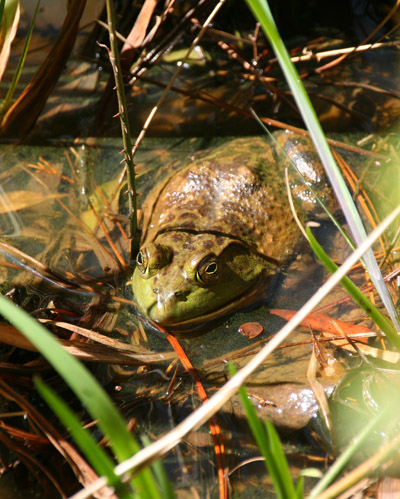 If one looked close, some of the leopard frogs that resided in the garden could be found, as well as a handful of tadpoles, but this is an American bullfrog (Lithobates catesbeianus,) usually hard to spot because they’re both secretive and primary nocturnal. None of the amphibian species were sounding off yet, save for one isolated call – they were simply basking in the sun, absorbing energy after their winter hibernation. There was nothing I could get into this image to show scale very well, but if it helps, I would have recommended keeping small children and lap dogs away from this specimen, notably larger than my fist. Given the very small size of the pond it was within, this is likely the only frog species to inhabit it, since bullfrogs will readily eat other frogs, as well as just about anything else. However, it was successfully avoiding two massive snapping turtles that also inhabit the pond – it’s a little surprising the balances that can take place even in very small habitats. It’s also quite possible that the presence of both species successfully prevented the increase in population between them, each preying on the offspring of the other. Either way, dabbling one’s fingers in the pond is not a recommended activity…
If one looked close, some of the leopard frogs that resided in the garden could be found, as well as a handful of tadpoles, but this is an American bullfrog (Lithobates catesbeianus,) usually hard to spot because they’re both secretive and primary nocturnal. None of the amphibian species were sounding off yet, save for one isolated call – they were simply basking in the sun, absorbing energy after their winter hibernation. There was nothing I could get into this image to show scale very well, but if it helps, I would have recommended keeping small children and lap dogs away from this specimen, notably larger than my fist. Given the very small size of the pond it was within, this is likely the only frog species to inhabit it, since bullfrogs will readily eat other frogs, as well as just about anything else. However, it was successfully avoiding two massive snapping turtles that also inhabit the pond – it’s a little surprising the balances that can take place even in very small habitats. It’s also quite possible that the presence of both species successfully prevented the increase in population between them, each preying on the offspring of the other. Either way, dabbling one’s fingers in the pond is not a recommended activity…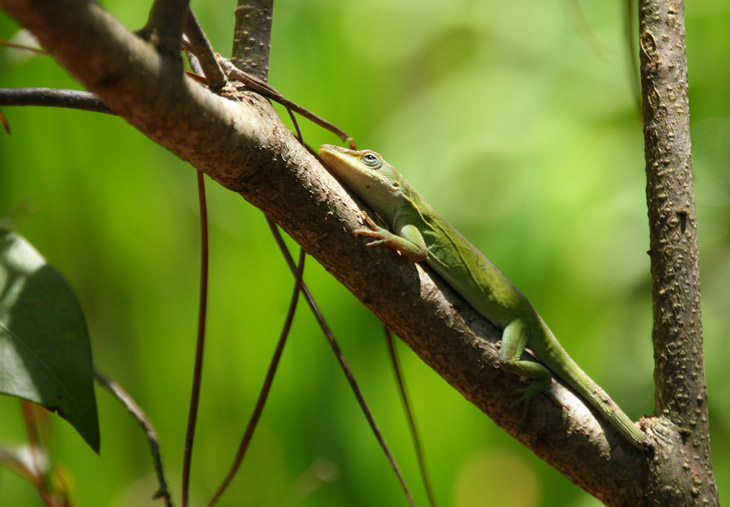 Were either of those species responsible for the foreshortened state of my next subject? It’s impossible to say, though in this area, birds are far more often the culprit. Since the garden is a
Were either of those species responsible for the foreshortened state of my next subject? It’s impossible to say, though in this area, birds are far more often the culprit. Since the garden is a 